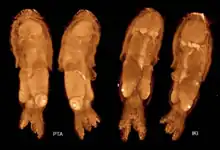Idiosepius
Idiosepius is a genus of squids in the family Idiosepiidae.[2] They are small, reaching mantle lengths of no more than about 21 mm (0.8 in);[3] members of this genus represent no interest to commercial fisheries.[4] They occur in tropical and temperate waters throughout the Indo-Pacific, primarily in association with seagrass and mangrove roots.[3]
| Idiosepius | |
|---|---|
 | |
| Newly hatched Idiosepius pygmaeus | |
| Scientific classification | |
| Domain: | Eukaryota |
| Kingdom: | Animalia |
| Phylum: | Mollusca |
| Class: | Cephalopoda |
| Order: | Idiosepida |
| Family: | Idiosepiidae |
| Genus: | Idiosepius Steenstrup, 1881[1] |
| Type species | |
| Idiosepius pygmaeus Steenstrup, 1881 | |
| Synonyms | |
| |
Species
The following species are recognised in the genus Idiosepius:[2]
- Idiosepius hallami Reid & Strugnell, 2018[3]
- Idiosepius minimus (d'Orbigny in Férussac & d'Orbigny, 1835)[5]
- Idiosepius paradoxus (Ortmann, 1888)[6]
- Idiosepius picteti (Joubin, 1894)[7]
- Idiosepius pygmaeus Steenstrup, 1881[1]
- Idiosepius thailandicus Chotiyaputta, Okutani & Chaitiamvong, 1991[8]
References
- Steenstrup, J. (1881). Sepiadarium og Idiosepius to nye Slægter af Sepiernes Familie. Med Bemaerkninger om de to beslaegtede former Sepiolidea D'Orb. og Spirula Lmk. Det Kongelige Danske videnskabernes selskabs skrifter; Naturvidenskabelig og mathematisk afdeling, 1(3), 211–242.
- "Idiosepius Steenstrup, 1881". WoRMS. World Register of Marine Species. Retrieved 2023-03-23.
- Reid, Amanda L. & Strugnell, Jan M. (2018). "A new pygmy squid, Idiosepius hallami n. sp. (Cephalopoda: Idiosepiidae) from eastern Australia and elevation of the southern endemic 'notoides' clade to a new genus, Xipholeptos n. gen". Zootaxa. 4369 (4): 451486. doi:10.11646/zootaxa.4369.4.1. PMID 29689867.
- Reid, A. 2005. Family Idiosepiidae. In: P. Jereb & C.F.E. Roper, eds. Cephalopods of the world. An annotated and illustrated catalogue of species known to date. Volume 1. Chambered nautiluses and sepioids (Nautilidae, Sepiidae, Sepiolidae, Sepiadariidae, Idiosepiidae and Spirulidae). FAO Species Catalogue for Fishery Purposes. No. 4, Vol. 1. Rome, FAO. pp. 208–210.
- Férussac, A. & d'Orbigny, A. (1835). Histoire naturelle générale et particulière des Céphalopodes acétabulifères vivants et fossiles. Paris: Baillière.
- Ortmann, A. (1888). Japanische Cephalopoden. Zoologische Jahrbücher, Systematik, 3, 639–670
- Joubin, L. (1894). Céphalopodes d'Amboine. Revue Suisse de Zoologie et Annales du Musée d'Historie Naturelle le Genèva, 2, 23–64.
- Chotiyaputta, C.; Okutani, T. & Chaitiamvong, S. (1991). "A new pygmy cuttlefish from the Gulf of Thailand, Idiosepius thailandicus n. sp. (Cephalopoda: Idiosepiidae)". Venus. 50 (3): 165–174.
- von Boletzky, S., et al. 2005. "Idiosepius: Ecology, Biology and Biogeography of a Mini-maximalist". (51.9 KiB) Phuket mar. biol. Cent. Res. Bull. 66: 11–22.
This article is issued from Wikipedia. The text is licensed under Creative Commons - Attribution - Sharealike. Additional terms may apply for the media files.